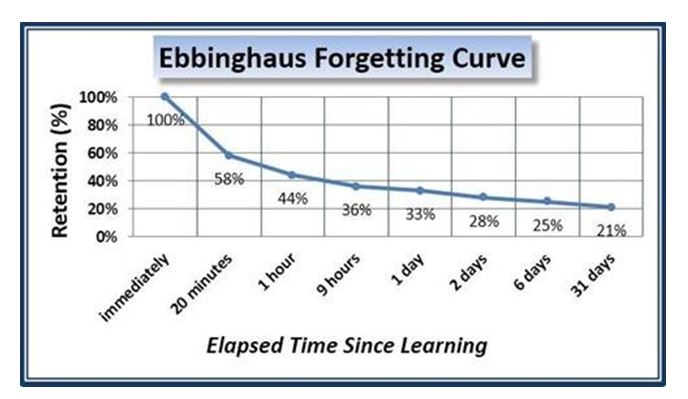Our Brain is an organ that is taken for granted to retain as much information as possible. However, our brain also forgets. To explain how fast or slow the brain tends to forget information researchers refer to what is called – the forgetting curve.
What is the forgetting curve?
The forgetting curve is a graph of data that describes how brain retention power decreases with time. Hermann Ebbinghaus was the first person who studied about the human forgetting behavior in his experiments. He had performed a number of memory experiments on himself over a period of time. The data from the experiments were recorded and analyzed thereafter to give rise to the shape of the forgetting curve. He concluded that forgetting happens in an exponential way.

Given above is a typical forgetting curve. At the very beginning, the brain retention is 100%, that is, at the time point when you actually learned some new information. As shown in the graph, with time the retention drops in a sharp manner sharply down to around 40% within a short span of time.
Explaining the Forgetting Curve
According to the forgetting curve maximum memory loss happens during the first few days. Later the rate of forgetting gets slower as shown by a lesser steepness on the right side of the graph.
Coming to the forgetting speed, it depends on a bunch of different factors:
- The difficulty level of the information that you acquired or learned.
- The ease of relating the new piece of information to existing facts in your brain
- The mode of information representation (audio, visual, audio-visual, etc.)
- The conditions under which you learned the new information. For example: normal or stressed condition.
- Your physical health conditions. For example: rested or tired
Everybody does not learn in the same manner
Every person differs in their capacity to absorb, learn as well as retain information. However, the shape of the forgetting curve for every individual for base tests (like memorizing nonsensical words) is almost identical. So, the differences that are seen from person to person in retaining information arise due to the difference in their acquired learning behaviors.
Also, there are different kinds of learners. Some people transform the new piece of information into a memory representation that seems more suitable for their individual personality. For example: People who retain more from audio mode are called as audio oriented learners and the ones who are more comfortable with video lessons are called as visually oriented learners. There are also kinds of people who naturally have a better capacity to use the brain memory hooks and other kinds of mnemonic techniques. Hence they tend to remember effortlessly and can relate the new information to the ones that they already are aware of.
Read: How to Memorize What You Learn Better
Tips to increase your memory:
- Try to co-relate new information with something that you already know. This way you will be able to use memory hooks and mnemonic devices to remember the new information with respect to the old ones.
- Try to recall or activate the newly learned information at regular intervals of time. Do not re-read but recall. This will force your brain to activate that memory and thus deepen neural connections associated with it.
- Make use of the spaced repetition software that calculates the exact time when you will make the most out of your study revision, i.e., the exact time when you are about to forget an information, spaced repetition will alert you to revise it again.
- Use the mode of information representation for learning that suits you best. Example: audio, visual, audio-visual, etc.













